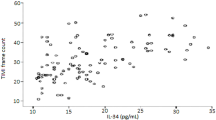Abstract
There is accumulating evidence that inflammation plays a major role in the development of the slow coronary flow (CSF) phenomenon. In this study, we aimed to study the new biomarker adroin levels as it relates to CSF. Patients who underwent coronary angiography before and had no significant epicardial coronary disease were included in the study. Patients who had thrombolysis in myocardial infarction frame counts (TFCs) above the normal cutoffs were considered to have CSF and those within normal limits were considered to have normal coronary flow (NCF). NCF group over the age of 30 were selected from patients with normal coronary arteries. The adropin levels and biochemical profiles of all patients were studied and analyzed with coronary flow parameters. There were 58 patients in the CSF group and 50 patients in the NCF group. The mean adropin level was significantly lower in CSF group than in NCF group (3.2 ± 0.71 vs. 4.9 ± 1.51 ng/mL, p < 0.001).There was a significant correlation between the adropin levels and TFC (r = −0.676, p < 0.001). Multivariable regression analysis showed that the adropin levels were an independent predictor of the CSF phenomenon (odds ratio = 1.041, 95 % confidence interval: 1.004–1.114, p = 0.014). In this study, we show that patients with CSF have decreased levels of adropin. We further show a strong correlation between the adropin levels and coronary blood flow. We conclude that decreased adropin levels might be a useful tool in predicting CSF in patients who undergo coronary angiography.

Similar content being viewed by others
References
Dogan M, Akyel A, Cimen T, Bilgin M, Sunman H, Kasapkara HA et al. Relationship between neutrophil to lymphocyte ratio and slow coronary flow. Clin Appl Thromb Hemost. 2013 Jul 26. [Epub ahead of print].
Tambe AA, Demany MA, Zimmerman HA, Mascarenhas E. Angina pectoris and slow flow velocity of dye in coronary arteries: a new angiographic finding. Am Heart J. 1972;84(1):66–71.
Sezgin AT, Sigirci A, Barutcu I, Topal E, Sezgin N, Ozdemir R, et al. Vascular endothelial function in patients with slow coronary flow. Coron Artery Dis. 2003;14(2):155–61.
Cin VG, Pekdemir H, Camsar A, Ciçek D, Akkus MN, Parmaksýz T, et al. Diffuse intimal thickening of coronary arteries in slow coronary flow. Jpn Heart J. 2003;44(6):907–19.
Mosseri M, Yarom R, Gotsman MS, Hasin Y. Histologic evidence for small vessel coronary artery disease in patients with angına pectoris and patent large coronary arteries. Circulation. 1986;74(5):964–72.
Kalay N, Aytekin M, Kaya MG, Ozbek K, Karayakalı M, Söğüt E, et al. The relationship between inflammation and slow coronary flow: increased red cell distribution width and serum uric acid levels. Turk Kardiyol Dern Ars. 2011;39(6):463–8.
Turhan H, Saydam GS, Erbay AR, Ayaz S, Yasar AS, Aksoy Y, et al. Increased plasma soluble adhesion molecules; ICAM-1, VCAM-1, and E-selectin levels in patients with slow coronary flow. Int J Cardiol. 2006;108(2):224–30.
Lovren F, Pan Y, Quan A, Singh KK, Shukla PC, Gupta M, et al. Adropin is a novel regulator of endothelial function. Circulation. 2010;122:S185–92.
Kathir K, Adams MR. Endothelial dysfunction as a predictor of acute coronary syndromes. Semin Vasc Med. 2003;3(4):355–62.
Wu L, Fang J, Chen L, Zhao Z, Luo Y, Lin C, et al. Low serum adropin is associated with coronary atherosclerosis in type 2 diabetic and non-diabetic patients. Clin Chem Lab Med. 2013;9:1–8.
Yilmaz MB, Balbay Y, Caldir V, Ayaz S, Guray Y, Guray U, et al. Late saphenous vein graft occlusion in patients with coronary bypass: possible role of aspirin resistance. Thromb Res. 2005;115:25–9.
Gibson CM, Cannon CP, Daley WL, Dodge JT Jr, Alexander B Jr, Marble SJ, et al. TIMI frame count: a quantitative method of assessing coronary artery flow. Circulation. 1996;93(5):879–88.
Isik T, Ayhan E, Uyarel H, Ergelen M, Tanboga IH, Kurt M, et al. Increased mean platelet volume associated with extent of slow coronary flow. Cardiol J. 2012;19:355–62.
Gokce M, Kaplan S, Tekelioglu Y, Erdogan T, Kucukosmanoglu M. Platelet function disorder in patients with coronary slow flow. Clin Cardiol. 2005;28(3):145–8.
Pekdemir H, Cin VG, Cicek D, Camsari A, Akkus N, Döven O, et al. Slow coronary flow may be a sign of diffuse atherosclerosis. Contribution of FFR and IVUS. Acta Cardiol. 2004;59(2):127–33.
Yucel H, Ozaydin M, Dogan A, Erdogan D, Icli A, Sutcu R. Evaluation of plasma oxidative status in patients with slow coronary flow. Kardiol Pol. 2013;71(6):588–94.
Barutcu I, Sezgin AT, Sezgin N, Gullu H, Esen AM, Topal E, et al. Increased high sensitive CRP level and its significance in pathogenesis of slow coronary flow. Angiology. 2007;58(4):401–7.
Li JJ, Qin XW, Li ZC. Increased plasma C-reactive protein and interleukin-6 concentrations in patients with slow coronary flow. Clin Chim Acta. 2007;385(1–2):43–7.
Kuloglu T, Aydin S. Immunohistochemical expressions of adropin and inducible nitric oxide synthase in renal tissues of rats with streptozotocin-ınduced experimental diabetes. Biotech Histochem. 2014;89(2):104–10.
Ignarro LJ. Nitric oxide as a unique signaling molecule in the vascular system: a historical overview. J Physiol Pharmacol. 2002;53:503–14.
Mottillo S, Filion KB, Genest J, Joseph L, Pilote L, Poirier P, et al. The metabolic syndrome and cardiovascular risk asystematic review and metaanalysis. J Am Coll Cardiol. 2010;56:1113–32.
Conflict of Interest
None.
Author information
Authors and Affiliations
Corresponding author
Rights and permissions
About this article
Cite this article
Demircelik, B., Kurtul, A., Ocek, H. et al. The Relationship Between Adropin Levels and the Slow Coronary Flow Phenomenon. Ind J Clin Biochem 30, 412–417 (2015). https://doi.org/10.1007/s12291-014-0470-0
Received:
Accepted:
Published:
Issue Date:
DOI: https://doi.org/10.1007/s12291-014-0470-0




